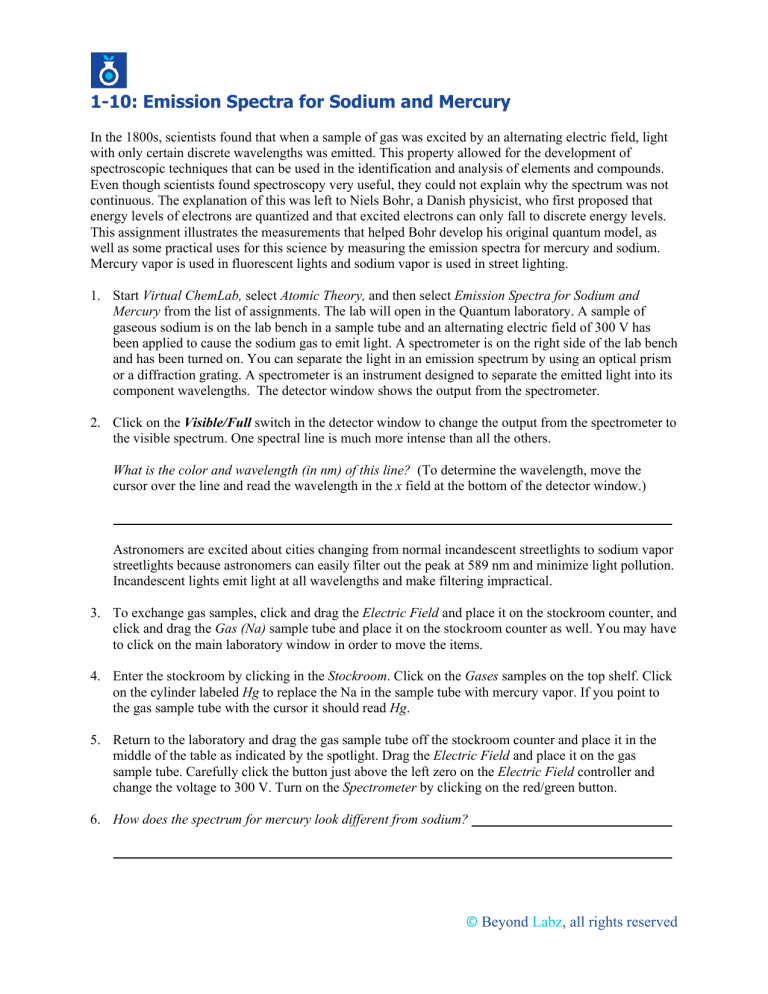
1-10: Emission Spectra for Sodium and Mercury In the 1800s, scientists found that when a sample of gas was excited by an alternating electric field, light with only certain discrete wavelengths was emitted. This property allowed for the development of spectroscopic techniques that can be used in the identification and analysis of elements and compounds. Even though scientists found spectroscopy very useful, they could not explain why the spectrum was not continuous. The explanation of this was left to Niels Bohr, a Danish physicist, who first proposed that energy levels of electrons are quantized and that excited electrons can only fall to discrete energy levels. This assignment illustrates the measurements that helped Bohr develop his original quantum model, as well as some practical uses for this science by measuring the emission spectra for mercury and sodium. Mercury vapor is used in fluorescent lights and sodium vapor is used in street lighting. 1. Start Virtual ChemLab, select Atomic Theory, and then select Emission Spectra for Sodium and Mercury from the list of assignments. The lab will open in the Quantum laboratory. A sample of gaseous sodium is on the lab bench in a sample tube and an alternating electric field of 300 V has been applied to cause the sodium gas to emit light. A spectrometer is on the right side of the lab bench and has been turned on. You can separate the light in an emission spectrum by using an optical prism or a diffraction grating. A spectrometer is an instrument designed to separate the emitted light into its component wavelengths. The detector window shows the output from the spectrometer. 2. Click on the Visible/Full switch in the detector window to change the output from the spectrometer to the visible spectrum. One spectral line is much more intense than all the others. What is the color and wavelength (in nm) of this line? (To determine the wavelength, move the cursor over the line and read the wavelength in the x field at the bottom of the detector window.) Astronomers are excited about cities changing from normal incandescent streetlights to sodium vapor streetlights because astronomers can easily filter out the peak at 589 nm and minimize light pollution. Incandescent lights emit light at all wavelengths and make filtering impractical. 3. To exchange gas samples, click and drag the Electric Field and place it on the stockroom counter, and click and drag the Gas (Na) sample tube and place it on the stockroom counter as well. You may have to click on the main laboratory window in order to move the items. 4. Enter the stockroom by clicking in the Stockroom. Click on the Gases samples on the top shelf. Click on the cylinder labeled Hg to replace the Na in the sample tube with mercury vapor. If you point to the gas sample tube with the cursor it should read Hg. 5. Return to the laboratory and drag the gas sample tube off the stockroom counter and place it in the middle of the table as indicated by the spotlight. Drag the Electric Field and place it on the gas sample tube. Carefully click the button just above the left zero on the Electric Field controller and change the voltage to 300 V. Turn on the Spectrometer by clicking on the red/green button. 6. How does the spectrum for mercury look different from sodium? © Beyond Labz, all rights reserved Mercury vapor is used in the fluorescent light tubes that you see at school and home. The emitted light is not very bright for just the mercury vapor, but when scientists examined the full spectrum for mercury they saw what you just observed. There is an enormous emission in the ultraviolet region (UV). This light is sometimes called black light. You may have seen it with glow-in-the-dark displays. Scientists coat the inside of the glass tube of fluorescent light tubes with a compound that will absorb UV and emit the energy as visible light with all the colors of the visible spectrum. All colors together create white light, which is why fluorescent light tubes emit very white light. Laundry detergents contain compounds that absorb UV light and emit visible light. These compounds allow advertisers to claim whiter and brighter whites and colors. If you attend an event using black light, you may have seen your white socks or white shirt “glow.” © Beyond Labz, all rights reserved




